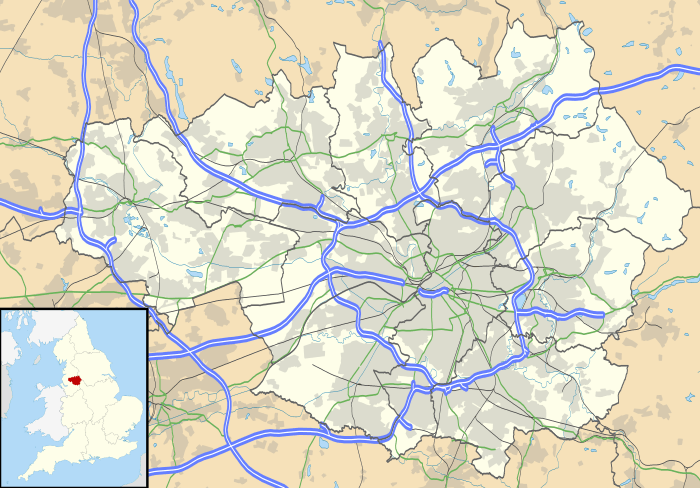Broadbottom
Broadbottom is a village in Tameside, Greater Manchester, England. Historically in Cheshire, it stands on the River Etherow which forms the border with Derbyshire.
| Broadbottom | |
|---|---|
.jpg) Magdalene Centre, Broadbottom | |
 Broadbottom Location within Greater Manchester | |
| OS grid reference | SJ988938 |
| Metropolitan borough | |
| Metropolitan county | |
| Region | |
| Country | England |
| Sovereign state | United Kingdom |
| Post town | HYDE |
| Postcode district | SK14 |
| Dialling code | 01457 |
| Police | Greater Manchester |
| Fire | Greater Manchester |
| Ambulance | North West |
| UK Parliament | |
Description
Home Farm dates from 1604, and Broadbottom Hall from 1680.
There was a 14th-century water-powered corn mill, and Moss Mill, an 18th-century woollen mill which changed to cotton in the 19th century.
Broadbottom has one remaining textile mill that is still currently operating. The factory mill is next to the River Etherow and is called Lymefield Mill. It is currently occupied by Tiviot Prints Ltd.
Landmarks
At Summerbottom there is a row of 18th-century weavers' cottages; they had a communal top floor where the looms were stored.
Hodge Printworks started out as a woollen mill in 1798. In 1805 it was converted into a dyeworks. The dyed cloth was of such high quality that some pieces are still on display in the Victoria and Albert Museum. In 1986, a team of archaeologists excavated the dye vats.
Best Hill Mill was started in 1784 by John Marsland, but closed in 1884. The mill reopened early in the 20th century to make tape and webbing for use in World War I. It closed again in 1930.
Broad Mills was a collection of mills (factories), including a calico printing mill, run by the Sidebottom family. In the 1840s it ran 25,000 spindles and 1,500 looms. In 1860, there were 1,200 people working there. The mill was bought by the John Hirst & Sons in 1872. In 1889 it became part of Broadbottom Mills Ltd who also owned Lymefield Mill. In 1906 it passed to the Broad Mills Co. Ltd., who worked it until 1934 when they went into liquidation. A fire in the 1940s led to the mills' demolition in 1949. Lymefield Visitor Centre is close to the mills.[1]
In 1842, the railway reached Broadbottom and a station was built on the Manchester–Glossop Line. A 120-foot-high (37 m) and 422-foot-long viaduct (129 m) over the River Etherow was constructed.
Community
Broadbottom Community Association organizes events throughout the year for the local residents. Their programme can be found on their website.[2] The BCA has published a book about the history of Broadbottom compiled by local resident Mollie Sayer.[3]
Broadbottom Cricket Club plays in the Derbyshire and Cheshire League.
See also
References
- Quayle, Tom (2006). The Cotton Industry in Longdendale and Glossopdale. Stroud,Gloucestershire: Tempus. p. 119. ISBN 0-7524-3883-2.
- Community website
- Sayer, Mollie. The History of Broadbottom Village (1795–1975).
External links
| Wikimedia Commons has media related to Broadbottom. |